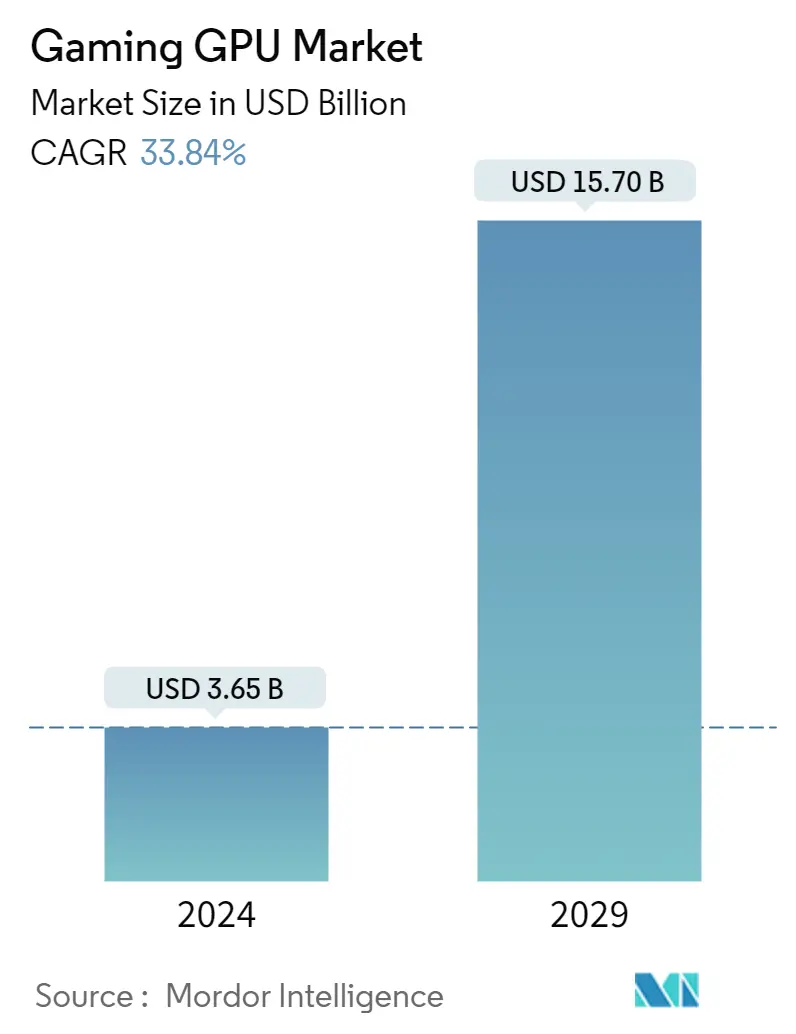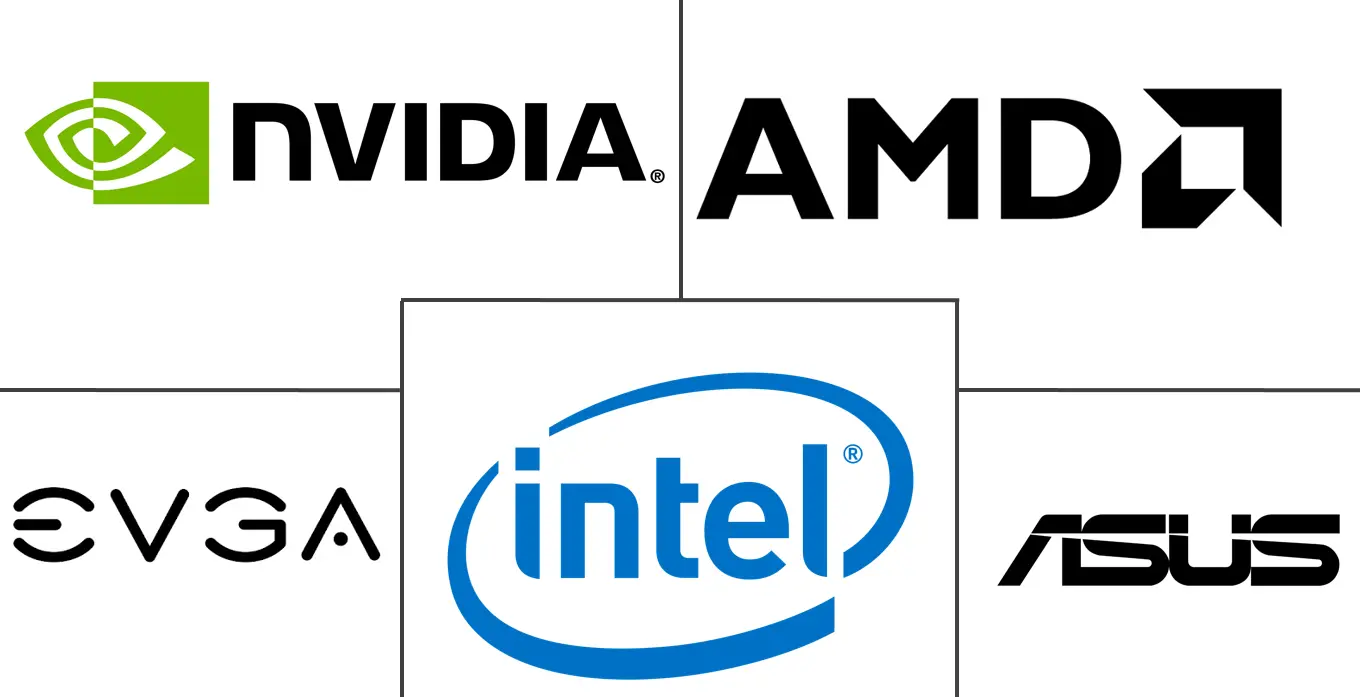Market Size of Gaming GPU Industry

| Study Period | 2019 - 2029 |
| Market Size (2024) | USD 3.65 Billion |
| Market Size (2029) | USD 15.70 Billion |
| CAGR (2024 - 2029) | 33.84 % |
| Fastest Growing Market | Asia-Pacific |
| Largest Market | North America |
| Market Concentration | High |
Major Players
*Disclaimer: Major Players sorted in no particular order |
Gaming GPU Market Analysis
The Gaming GPU Market size is estimated at USD 3.65 billion in 2024, and is expected to reach USD 15.70 billion by 2029, growing at a CAGR of 33.84% during the forecast period (2024-2029).
The rising gamification trend among millennials has led to the increasing adoption of a virtual world for video gamers. Gaming machines have also evolved from powerful location-based devices found in restaurants, arcades, and bars to in-home machines in the form of gaming consoles and then PCs. As Moore's Law drove down chip prices and increased performance, people bought more gaming machines for the home, which has a positive price elasticity effect at the expense of location-based gaming machines. As gaming machine sales have increased in the last few years, the demand for gaming GPUs has grown significantly.
- The demand for high-end computing systems for graphics-intensive gaming applications has increased with the rising adoption of smartphones, tablets, PCs, and consoles for gaming purposes. The growing demand for specialized processors that can handle complex mathematical calculations related to the 2D and 3D graphics required for gaming drives the GPU market demand.
- Technological advancement in high-performing computing may also develop an opportunity for GPU vendors. For instance, in April this year, Nvidia stated that researchers discovered trends in Hubble data on April 25 using a supercomputer with NVIDIA GPUs. Also, high-performance computing is used with NVIDIA GPUs to increase the understanding of all planets and analyze their torrid atmospheres.
- Other drivers for the market include industry verticals such as automotive, manufacturing, real estate, and healthcare, with the rising usage of processors to support graphics applications and 3D content. For instance, in manufacturing and design applications in the automotive sector, CAD and simulation software uses GPUs to create realistic images and animations for critical applications.
- Gaming GPUs use advanced technologies and materials. One of the primary factors contributing to the high price of current GPUs is higher manufacturing expenses. Only the materials that producers can afford can be produced. Producers are thinking of maximizing their profits without sacrificing a product's quality or quantity due to rising manufacturing costs, which cause a rise in the selling price of the GPU. Due to this huge initial investment, consumers prefer to use something other than the latest gaming GPU in their devices, which is a challenge for market growth.
- Modern-day video game consoles and servers utilize many components, including gaming GPU circuits. COVID-19 threatened the average production of many of these components due to supply chain problems. However, semiconductor foundries started resuming production, which motivated manufacturers in the market. Demand in cloud computing, gaming, data center servers, automation, and AI technologies could help GPU manufacturers revive growth in the later part of the pandemic.
Gaming GPU Industry Segmentation
Gaming GPU is a specialized electronic circuit created to manipulate and change memory to speed up the production of images in a frame buffer intended for output to a display device. They are important for gaming applications because they can process many data simultaneously.
Gaming GPU Market is Segmented by Type (Dedicated Graphic Cards, Integrated Graphics Solutions), Device (Mobile Devices, PCs & Workstations, Gaming Consoles, Automotive), and Geography (North America, Europe, Asia Pacific, Latin America, and Middle East & Africa).
The market sizes and forecasts are provided in terms of value (in USD million) for all the above segments.
| Type | |
| Dedicated Graphic Cards | |
| Integrated Graphics Solutions | |
| Other Market Types |
| Device | |
| Mobile Devices | |
| PCs and Workstations | |
| Gaming Consoles | |
| Automotive | |
| Other Devices |
| Geography | |
| North America | |
| Europe | |
| Asia Pacific | |
| Latin America | |
| Middle East and Africa |
Gaming GPU Market Size Summary
The gaming GPU market is poised for substantial growth, driven by the increasing popularity of gaming across various platforms such as PCs, consoles, and mobile devices. The evolution of gaming from location-based machines to in-home consoles and PCs has significantly boosted the demand for gaming GPUs. This shift is further accelerated by the rising trend of gamification among millennials, who are increasingly engaging with virtual worlds. Technological advancements, such as those driven by Moore's Law, have made gaming machines more affordable and powerful, enhancing their appeal. The demand for high-end computing systems capable of handling complex graphics for gaming applications is a key factor propelling the market forward. Additionally, the integration of GPUs in industries like automotive, manufacturing, and healthcare for graphics-intensive applications is expanding the market's reach beyond traditional gaming.
The market is also experiencing a surge in interest due to the rise of cloud gaming and esports, which offer new avenues for growth. Companies like Blade are pioneering cloud gaming services, allowing users to access powerful gaming PCs remotely, while major game developers focus on creating high-quality console-based games. The increasing incorporation of augmented and virtual reality applications is expected to further drive GPU adoption, as advancements in graphics technology enable more immersive experiences. Despite challenges such as high manufacturing costs and supply chain disruptions, the market is recovering, with semiconductor foundries resuming production. The North American region, in particular, is witnessing significant investments from major technology players, enhancing the market's growth prospects. The gaming GPU market is characterized by a few dominant players who are investing in research and development, strategic alliances, and product innovations to maintain their competitive edge.
Gaming GPU Market Size - Table of Contents
-
1. MARKET INSIGHTS
-
1.1 Market Overview
-
1.2 Industry Attractiveness - Porter's Five Forces Analysis
-
1.2.1 Threat of New Entrants
-
1.2.2 Bargaining Power of Buyers
-
1.2.3 Bargaining Power of Suppliers
-
1.2.4 Threat of Substitutes
-
1.2.5 Intensity of Competitive Rivalry
-
-
1.3 Industry Value Chain Analysis
-
1.4 Assessment of Impact of COVID-19 on the Industry
-
1.5 Market Drivers
-
1.5.1 Rising Demand for Gaming Consoles, Augmented Reality (AR), and Virtual Reality (VR) in the industry
-
1.5.2 Increasing Demand for Advanced Displays with Higher Refresh Rates
-
-
1.6 Market Restraints
-
1.6.1 High Initial Investment
-
-
-
2. MARKET SEGMENTATION
-
2.1 Type
-
2.1.1 Dedicated Graphic Cards
-
2.1.2 Integrated Graphics Solutions
-
2.1.3 Other Market Types
-
-
2.2 Device
-
2.2.1 Mobile Devices
-
2.2.2 PCs and Workstations
-
2.2.3 Gaming Consoles
-
2.2.4 Automotive
-
2.2.5 Other Devices
-
-
2.3 Geography
-
2.3.1 North America
-
2.3.2 Europe
-
2.3.3 Asia Pacific
-
2.3.4 Latin America
-
2.3.5 Middle East and Africa
-
-
Gaming GPU Market Size FAQs
How big is the Gaming GPU Market?
The Gaming GPU Market size is expected to reach USD 3.65 billion in 2024 and grow at a CAGR of 33.84% to reach USD 15.70 billion by 2029.
What is the current Gaming GPU Market size?
In 2024, the Gaming GPU Market size is expected to reach USD 3.65 billion.

